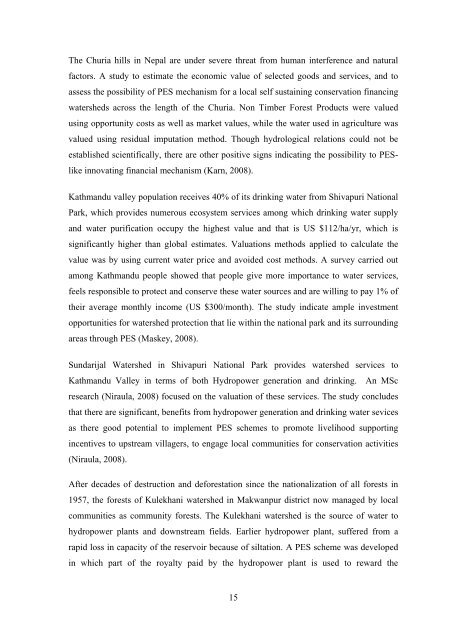Scope of Payment for Ecosystem Services Mechanism for ... - icimod
Scope of Payment for Ecosystem Services Mechanism for ... - icimod
Scope of Payment for Ecosystem Services Mechanism for ... - icimod
You also want an ePaper? Increase the reach of your titles
YUMPU automatically turns print PDFs into web optimized ePapers that Google loves.
The Churia hills in Nepal are under severe threat from human interference and naturalfactors. A study to estimate the economic value <strong>of</strong> selected goods and services, and toassess the possibility <strong>of</strong> PES mechanism <strong>for</strong> a local self sustaining conservation financingwatersheds across the length <strong>of</strong> the Churia. Non Timber Forest Products were valuedusing opportunity costs as well as market values, while the water used in agriculture wasvalued using residual imputation method. Though hydrological relations could not beestablished scientifically, there are other positive signs indicating the possibility to PESlikeinnovating financial mechanism (Karn, 2008).Kathmandu valley population receives 40% <strong>of</strong> its drinking water from Shivapuri NationalPark, which provides numerous ecosystem services among which drinking water supplyand water purification occupy the highest value and that is US $112/ha/yr, which issignificantly higher than global estimates. Valuations methods applied to calculate thevalue was by using current water price and avoided cost methods. A survey carried outamong Kathmandu people showed that people give more importance to water services,feels responsible to protect and conserve these water sources and are willing to pay 1% <strong>of</strong>their average monthly income (US $300/month). The study indicate ample investmentopportunities <strong>for</strong> watershed protection that lie within the national park and its surroundingareas through PES (Maskey, 2008).Sundarijal Watershed in Shivapuri National Park provides watershed services toKathmandu Valley in terms <strong>of</strong> both Hydropower generation and drinking. An MScresearch (Niraula, 2008) focused on the valuation <strong>of</strong> these services. The study concludesthat there are significant, benefits from hydropower generation and drinking water sevicesas there good potential to implement PES schemes to promote livelihood supportingincentives to upstream villagers, to engage local communities <strong>for</strong> conservation activities(Niraula, 2008).After decades <strong>of</strong> destruction and de<strong>for</strong>estation since the nationalization <strong>of</strong> all <strong>for</strong>ests in1957, the <strong>for</strong>ests <strong>of</strong> Kulekhani watershed in Makwanpur district now managed by localcommunities as community <strong>for</strong>ests. The Kulekhani watershed is the source <strong>of</strong> water tohydropower plants and downstream fields. Earlier hydropower plant, suffered from arapid loss in capacity <strong>of</strong> the reservoir because <strong>of</strong> siltation. A PES scheme was developedin which part <strong>of</strong> the royalty paid by the hydropower plant is used to reward the15
















